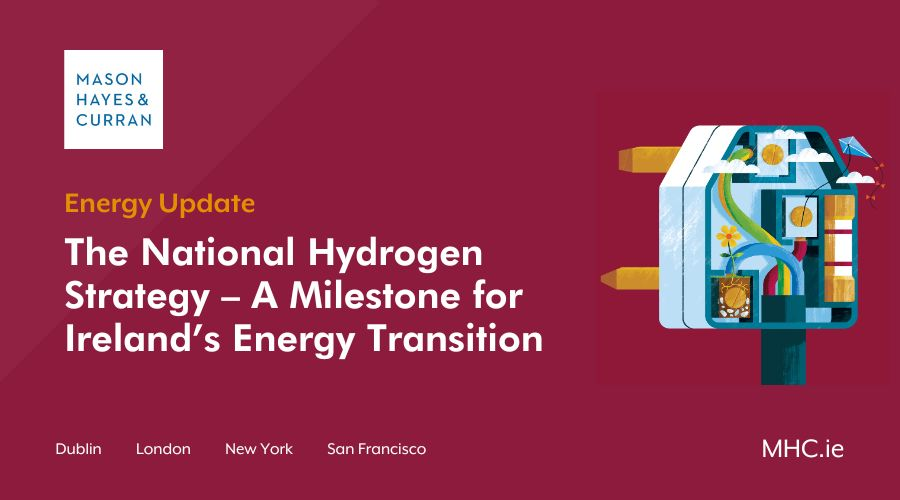The National Hydrogen Strategy – A Milestone for Ireland’s Energy Transition

The publication of the National Hydrogen Strategy (the Strategy) is a considerable step in the development of a green hydrogen industry in Ireland and Ireland’s decarbonisation journey. This long-awaited publication has been well received in the sector, with many stakeholders describing it as a key step in the right direction and broader than anticipated.
Key points
The key points in the Strategy include:
Clear objectives
The Strategy contains a list of 21 specific deliverables, to be actioned from now to 2030. These include commitments to:
- Establish an early hydrogen innovation fund to provide co-funding supports for hydrogen projects
- Adopt EU standards for renewable and low carbon hydrogen and develop a national certification scheme to provide clarity to end users as to the origin and sustainability of their hydrogen
- Review the existing licensing and regulatory regimes relevant to the storage of hydrogen
- Work to prove the technical capabilities of the gas network to transport hydrogen through the network, and
- Establish a working group with the relevant regulators, government, and industry representatives to develop a safety roadmap to delivering the necessary safety frameworks and regulatory regimes across the entire hydrogen value chain
Production of hydrogen
In the shorter term, surplus renewables will be utilised for grid-connected electrolysis to produce green hydrogen. As grid electrolysis raises questions regarding the true renewable nature of hydrogen produced, the Strategy also sets out the criteria under which grid electrolysis can be deemed to be renewable. The Strategy also confirms that an initial target of 2GW of offshore wind dedicated to the production of renewable hydrogen has been agreed and is targeted to be in development from 2030.
Routes to market
The Strategy stresses the importance of ensuring that we are focusing where we should be when it comes to routes to market for renewable hydrogen, noting that electrification remains a better option for decarbonising certain industries. Heavy duty transport is expected to be the main user of hydrogen in the short term, with this expanding to maritime and aviation use in the longer term. Hydrogen is not expected to play a role in commercial and residential space heating or in the passenger car fleet.
Transportation and storage
Compressed tankering solutions are expected to be the primary method for initial hydrogen transportation and storage in the short term. As hydrogen production and the hydrogen sector increases, it is anticipated that hydrogen pipelines will become the prevailing means of transportation. The deployment of hydrogen infrastructure is initially planned in regional clusters where production, high-priority demand and large-scale storage facilities are located together. In terms of blending into the current gas network, research carried out to date has shown promising results in terms of the technical capability of the gas network to transport hydrogen blends up to 100%. Interestingly, the Strategy specifically notes that it does not see blending through the existing gas network as a high priority end-use for renewable hydrogen, explaining that while blending may offer an initial demand sink in the short term, it can only be supported if it can prove to be a transitional step to the development of pure hydrogen transportation and end uses.
What’s next?
In recent years, Ireland has made strides to position itself as a future leader in green hydrogen development, with semi-state bodies spending time and money in considering how renewable hydrogen can be sustainably developed, transported and used in Ireland. In addition, stakeholders have emphasised Ireland’s abundance of wind energy and high levels of curtailment of electricity generation, which make it an ideal location for green hydrogen generation. The publication of the Strategy has increased this momentum, showing interested parties that there is a real opportunity in Ireland for renewable hydrogen production and the possibility in the long term for dedicated renewable capacity.
In terms of next steps, a detailed proposal by the Government on financial support and subsidy plans would be welcomed by all stakeholders, both as an incentive to develop and invest in projects in Ireland and as a measure to increase the financeability of hydrogen projects. Finally and as acknowledged in the Strategy, there are several gaps in terms of regulations, licensing and permitting across the entire hydrogen chain which need to be considered. This will not be resolved quickly given the extent of the work required. However, the publication of the Strategy is a welcome and critical step forward for the renewables industry in Ireland and Ireland’s decarbonisation journey generally.
We have advised on a number of early-stage hydrogen developments. If you would like to discuss any of the above or the renewable energy environment in Ireland more generally, please reach out to any member of our Energy team.
The content of this article is provided for information purposes only and does not constitute legal or other advice
Share this:



